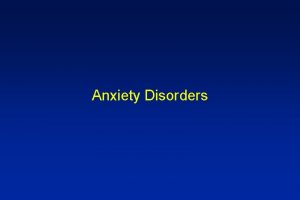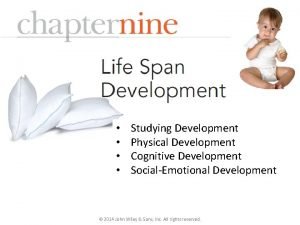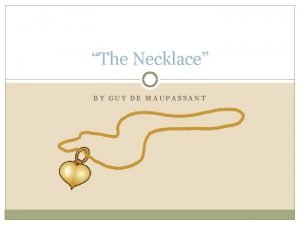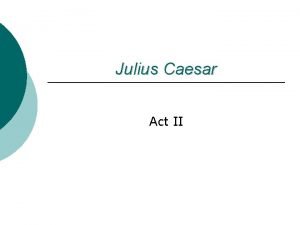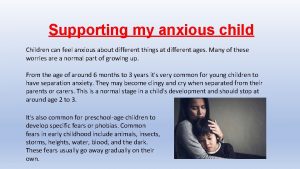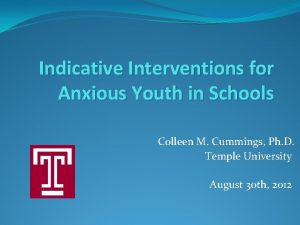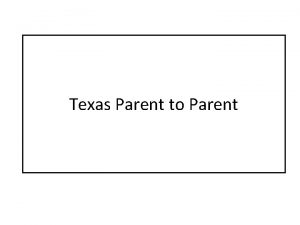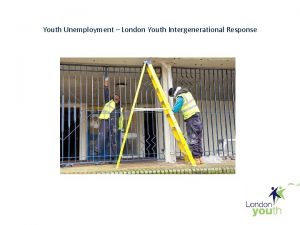Parent carerfocused interventions for anxious youth Dr Warren







































- Slides: 39

Parent- & carer-focused interventions for anxious youth Dr Warren Matofsky Clinical & Community Psychologist Sussex CAMHS

Session focus • Anxiety as inter-personal • Accommodation as key process in maintaining the problem • Support=Understanding + confidence • Mange own emotions & notice/limit accommodation

Anxiety & relationships Anxiety as internal anxiety as interpersonal

Dangers of giving advice/reassurance • The gender politics of advice giving https: //youtu. be/7 h. FAv 8 z 8 xmw • What emotions are passing back & forth on the phone? • Impact on advised • Research on advice giving • Link between parenting behaviours & child outcomes can only show what happens when parents make their own choices(Kraemer, 2009) • managing our own experience of the anxiety & modelling support

Research-based Principles

CAMHS parent/carer Workshop Outcomes (2015 -18) Number start workshop 107 % of starters complete 65% (of non-returners 50% sent apols) % show reliable change on CORS 72% % reporting house calmer 97% % showing reduction on FASA 65% Session 1 (/10) (n=107) 8. 6 (no gender diffs) Session 2 (/10) (n=69) 9. 2 (no gender diffs) Session 3 (/10) (n=64) 8. 9 (no gender diffs)

What is anxiety? • System to alert us to danger. Anxiety as a survival strategy. • Some anxiety necessary for child’s survival • Anxiety problems arise when child experiences high anxiety to things/situations that don’t pose real & present danger & starts to avoid them • Triggers-worries, repeated thoughts of danger, hidden internal sensations, assumptions about situation, misinterpreted signals, memories

What is an anxiety problem? Anxiety = Problem fear + avoidance

Avoidant behaviour • Behaviour driven by urgent need to limit anxiety • Leads to avoiding feared task, sensation or thought • Avoidance lowers discomfort briefly but increases likelihood that anxiety recurs & belief trigger is unbearable • Less experience of coping • Doing anything that makes sensation, thought or feeling go away immediately or avoid situations where they may occur

Cycle of anxiety trigger Temporary relief but belief can’t cope Avoidant safety behaviour View as threat Anxiety: feelings, sensations & thoughts

Avoidant safety behaviours • Action, thoughts, pattern of interacting • Neutralise anxiety rather than allowing natural extinction • Maintain intense aversion to signs anxiety • Maintain belief in inability to cope with anxiety

Responding to anxiety Young person anxiety Relationship Parent or helper anxiety is not interested in the kind of parent or helper you’d prefer to be

Exercise What effect does the anxiety of those we help have on us, as it arises, in a meeting? Physical sensations Thoughts Sense of competence as a professional Feelings

Anxiety as contagious • Supporting others with anxiety involves managing our own emotions • But this makes it complicated as our ability to manage depends on context………

Accommodation “the way others change their behaviour to help child avoid, alleviate or minimise anxiety” -often done out of awareness, automatically; -Challenge of moving responses as child develops -greater accommodation leads to more persistent problem with greater functional impairment (Leibowitz, 2015)

Common Accommodations Reassure again Reduce demands Take meals to child room Stay close to child Child in parent bed Do task for child Go along with want child wants even though parent/helper disagrees Let them off responsibility Relax rules Step in immediately when they find something stressful Do anything to stop another argument Shout/demand/badger Reacting immediately to child distress Not challenge concerning behaviour Keeping problem secret Self-blame/guilt, thus need to make it easier for child/stop distress Shout/demand/badger

Anxiety as interpersonal process 1. In response to anxiety child seeks parental/carer protection 2. Child distress triggers the attachment bond 3. Parent acts protectively/reassure/aid regulation of child’s negative feelings and assist avoidance 4. Parent supported avoidance maintains avoidant response, ↑ dependence on parent; prevents child practicing other ways to cope

Reacting to anxiety • Trying to protect the child • Forget that anxiety is not dangerous/harmful • Anxiety problems relate to impact of ongoing avoidance • It feels bad/terrible to experience others in distress • Our own attachment experiences • Not giving child chance to tolerate some distress

Guiding change • Accommodation as product of love/child’s next developmental stage • You can’t argue the anxiety out of the child’s life • Persuasion often leaves the child more defensive and leads to escalating conflict • Parents then drawn to attacking/giving in the face of avoidance • Lead the change you want rather than demand/instruct

The “how do I help? ” dilemma Look after them & help them feel better Show them they’ll be fine & tell them to get on with things

Responding to anxiety • Which message should I give? (1)Showing your child you understand their distress as real and provide comfort (2)Showing confidence in their ability to cope & steer them toward a little more coping with discomfort • These messages can get divided amongst people in the family, with each thinking we need more of their own message • But both are needed!

Support = Understanding + Confidence • Understanding: I accept you are afraid & see it’s real. • Confidence: I have faith in your ability to cope and believe you can tolerate what’s needed to get on. We’ll get through this. But this is tough because……. .

Protective & demanding roles • When parents only take on role of accepting children’s fear, re-assuring them or helping them avoid anxiety, that is protection. • When parents only expect their child to act bravely without recognising the difficulty or accepting the process is gradual, that is being demanding

Parent & helper thoughts • Demanding thoughts: It’s not frightening I’m ok so its alright Don’t be ridiculous Just do it for heaven’s sake, just like everyone else • Thoughts of protection: She can’t handle stress Its traumatising her to suffer like that My job is to protect her from all this

Shifting to support It’s not frightening • It scared you but I’m sure you’ll be ok She can’t • Its hard for her but she handle stress can learn to manage it I need to protect him • Its my job to prepare him for dealing with challenges in life

Promoting parental authority • Reject “whose the boss” debate • De-escalation • Authority from self-control & persistence • Reject controlling child or giving into child • Neither verbal persuasion or begging - arguments, persuasion, begging fuel escalation • Deferred response/Respond not react • But this is tough as depends on support for parent & their wellbeing

De-escalate conflict • Weathering the anxiety storm “strike when the iron’s cold” Calm needed to hear & act on feedback

When it’s hot…. • Focus on calming situation & safety rather than teaching lessons • Heat to be endured rather than a fire put out • Disengage & Distance to limit escalation Rather than “how can I make you do this? ” More “how can I stand by my own beliefs without giving in or attacking you? ”

Reflective practice exercise • Identify helping situation (with parent or youth) where felt pulled into demanding role • Identify helping situation (with parent or youth) where felt pulled into protective role • What was going on that made this pull more likely? • How did you manage the pull? • Which are you more drawn to protect/demand?

Intervention with parent/carers • • Notice accommodation & automatic reactions Replace accommodation with support Managing own emotions first Respond rather than react • Showing your intention not to give into the anxiety • Modelling support in how skilled helper responds to parent/carer

“Strike when the iron’s cold” (Leibowitz & Omer, 2013) • Manage your own anxiety; delaying your response; if your child is highly anxious they won’t be able to take in what you are saying • In continuing conflict , discussion leaves the child with the hope you will change your mind • The less you respond, the more quickly the emotion will subside • Parents disengage/distance to de-escalate • Be with rather than do for • Be kind to yourself- changing how we behave is hard & slow

REASSURANCE MAINTAINS THE ANXIETY Alternatives to repeated reassurance • Disrupt the pattern of reassurance (e. g. ask child to predict your response) • Provide reassurance once, then on future occasions refer to previous answer or ask child “what do you think I will say”? Disengage from further discussion • Fixed time for when reassurance provided e. g. onceon the hour • Have ten minutes worry time per day and remind child to bring worry up then • Respond to emotion rather than content “ you sound worried but I know you’ll cope with it” (support)

“Support not solutions” exercise • In pairs One skilled helper One parent of persistently anxious child • • Parent to seek out solutions Helper to limit reassurance/giving solutions Helper offer understanding/confidence Helper can pause at any time to notice their thoughts

Support not solutions exercise • Understanding Express empathy Say more about what happened How did that affect you? Thoughts & feelings Who understands how difficult that was for you Listening is making me feel anxious, what it like for you saying this? What helps you calm? • Confidence Has that happened before? What did you do? What are the options for you? What normally helps you with those feelings? How would you prefer tor respond if the anxiety wasn’t as bad?

Accommodation exercise • Identify alternative to accommodating behaviours for right hand column • Examplesfrom demand to support from protection to support from reassurance to support

Mapping accommodation Accommodating response Understanding message Confidence message

Mapping accommodation Accommodating response understanding confidence e. g. giving child coping strategy Its sounds like its hard to come up with any ideas to help Worker modelling emotional self-care e. g. answering repeated questions about time of visitor “it sounds like your quite “I told you the time earlier, worried about that? ” which lets get on with this task” emjoi captures where your at? Sitting with child throughout session “it sounds like its tough sitting here without me” “I wonder how you’ll get on over the next five minutes. Let me know. (exit)” Calling parent to collect them early It sounds like that thing you get when your anxious & it makes your tummy weird. Is that right? Sometimes it can help to take 5 minutes to think what all the options are. What’s on your list?

Further Learning • High quality on-line training via Mind. Ed From East Sussex Books on Prescription • https: //www. eastsussex. gov. uk/libraries/books-films-music/self-help-booksfamilies/ Cathy, C. & Willetts, L. (2007). Overcoming your child’s fears & worries: A Self-help Guide Using Cognitive Behavioral Techniques. UK: Robinson Timimi, S. (2009). A Straight-talking Introduction to Children's Mental Health Problems on child mental health. Ross-on-Wye: PCCS Books

Responding to anxiety (in 3 soundbites) Support = understanding + confidence Notice protective/demanding thoughts “A pause can turn a reaction into a response”
 Anxious arousal meaning
Anxious arousal meaning Anxious attachment quotes
Anxious attachment quotes Apprehensive vs anxious
Apprehensive vs anxious Cross sectional and longitudinal research difference
Cross sectional and longitudinal research difference Why had m. loisel been saving 400 francs?
Why had m. loisel been saving 400 francs? Anxiety vs apprehension
Anxiety vs apprehension Anxious gerund or infinitive
Anxious gerund or infinitive Psalm 94:17
Psalm 94:17 Why does brutus want to kill caesar
Why does brutus want to kill caesar Anxious gerund or infinitive
Anxious gerund or infinitive Fspos vägledning för kontinuitetshantering
Fspos vägledning för kontinuitetshantering Klassificeringsstruktur för kommunala verksamheter
Klassificeringsstruktur för kommunala verksamheter Myndigheten för delaktighet
Myndigheten för delaktighet Presentera för publik crossboss
Presentera för publik crossboss Tack för att ni lyssnade
Tack för att ni lyssnade Tes debattartikel
Tes debattartikel Tobinskatten för och nackdelar
Tobinskatten för och nackdelar En lathund för arbete med kontinuitetshantering
En lathund för arbete med kontinuitetshantering Tack för att ni har lyssnat
Tack för att ni har lyssnat Vad är referatmarkeringar
Vad är referatmarkeringar Stig karttecken
Stig karttecken Mitos steg
Mitos steg Shingelfrisyren
Shingelfrisyren Verifikationsplan
Verifikationsplan Rbk fuktmätning
Rbk fuktmätning Kraft per area
Kraft per area Kung dog 1611
Kung dog 1611 Förklara densitet för barn
Förklara densitet för barn Elektronik för barn
Elektronik för barn Tack för att ni har lyssnat
Tack för att ni har lyssnat Smärtskolan kunskap för livet
Smärtskolan kunskap för livet Typiska novell drag
Typiska novell drag Fimbrietratt
Fimbrietratt Trög för kemist
Trög för kemist Autokratiskt ledarskap
Autokratiskt ledarskap Samlade siffror för tryck
Samlade siffror för tryck Adressändring ideell förening
Adressändring ideell förening Toppslätskivling dos
Toppslätskivling dos Borra hål för knoppar
Borra hål för knoppar Redogör för vad psykologi är
Redogör för vad psykologi är


